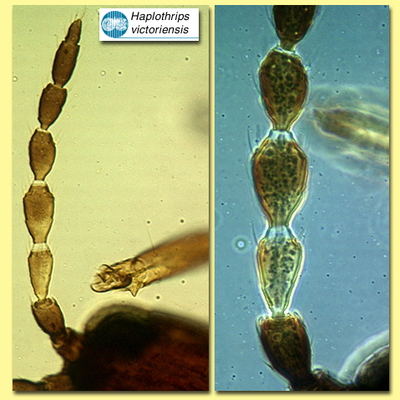Species
Haplothrips victoriensis BagnallFigures
Fig. 1 Antenna
Fig. 2 Pronotum
Fig. 3 Fore and hind wing
Fig. 4 Base of fore wing
Fig. 5 Tergite X (tube)
Biology
Flower-feeding but also predatory on two-spotted mites (Bailey & Caon, 1976).
Distribution
Widespread in southern Australia.
Recognition
Large dark thrips, antennal segment III yellowish brown; forewing pale with marginal area close to base of cilia shaded, and extreme base dark. Antennae 8-segmented; segment III with one sense cone, IV with 4 sense cones; segment III slightly shorter than IV. Head with maxillary stylets about one-third of head width apart, with distinct maxillary bridge; postocular setae dark with apex capitate. Pronotum with 5 pairs of dark major setae, anterior pairs much shorter than posterior pairs, all with capitate apex. Fore tarsus of female with minute tarsal tooth. Forewing constricted medially; distal posterior margin with about 10 duplicated cilia; first and second sub-basal seta dark with apex capitate, third seta pale with apex blunt. Tergites II-VII each with 2 pairs of sigmoid wing-retaining setae; tergite IX mid-dorsal setae with apex blunt, lateral setae acute.
Related species
There are many species amongst the 200 described in this genus that are similar in structure to this species, but the colour of the forewing with its weakly shaded margin is unusual.






